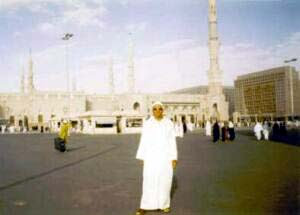From YesPakistan.com http://www.yespakistan.com/eid/running.asp Muslims who perform the Hajj or Umra must run in the middle portion of the distance between Safa and Marwa seven times. Safa and Marwa are two hills close to the Kaba. This is a commemoration of one mother’s sacrifice for her son. That mother was Hajira (may Allah be pleased with her). Her son was the Prophet Ismail (peace be upon him). Prophet Ibrahim (peace be upon him) was Hajira’s husband, and Ismail’s father. Hajira’s example of sacrifice took place when she and her baby was left in the valley of Makkah by Allah’s order as
Read MoreBy Muhammad ash-Shareef http://www.islamicawakening.com/viewarticle.php?articleID=165& Arafah 10 Years After Hijrah The man was standing with Rasul Allah sal Allahu alayhi wa sallam when he was thrown from his camel. The camel stomped and the man’s neck was snapped. Dead. “Bathe his body with water and Sidr and bury him with both garments,” said Allah’s Messenger. “Do not cover his head, nor touch him with Camphor … for verily he will be returned (to Allah) on the day of resurrection in the state of Talbiyah! (Labbayk Allahaahumma labbayk)” Al-Bukhari and Muslim “Amr ibn Al-“Aas narrates, “When Islam entered my heart, I went
Read MorePor Marta Khadija Contestando a la llamada de Alá en una viaje de Reflexión, Inspiración, Renacimiento, y Devoción, el pasado 25 de Mayo de 2009 seis hermanas, un hermano y yo salimos para el Medio Oriente con el propósito de hacer el ritual de Umra, el cual se lleva a cabo en Meca, Arabia Saudita. La mayoría de nosotros visitábamos Meca por primera vez. Desde la planeación de este viaje empezamos a experimentar una emoción muy grande, La cual fue creciendo a medida que el día de salida se aproximaba. Viajamos por la aerolínea Emiratos Unidos (Emirates), vuelo directo de
Read MoreBy Jesus Villarreal October 2007 I got an email from a friend of mine about an Islamic studies program in the United Arab Emirates. To be honest with you, it sounded too good to be true. The program would consist of six weeks of Arabic and Islamic studies with the chance to go to Hajj. With an announcement like this, I sought more information. What I found out was that there was going to be a limited number of seats available and the prospective students would have to submit a biography of themselves and an essay stating why they should
Read MoreBy Shariffa Carlo Al Andalusia http://www.islamicawakening.com/viewarticle.php?articleID=274 As a former Catholic, one of the things that has helped to strengthen my faith as a Muslim is the fact that everything in Islam is so clear and so protected. If we really want to know Allah and His deen, all we have to do is look. It is all here for us, preserved. As a Catholic, I did take my priest as a Lord above Allah. I would obey his edicts, no matter how contradictory because I believed he has some connection to God from which he was able to dictate right
Read MoreBy Imam Yusef Maisonet I will remember this Hajj for the rest of my life. In my forty years as a Muslim, I have never expected anything like this. Hajj 2007 was my third time on hajj. The first was by myself and the second time was with my wife. However, this time, hajj had a special meaning to it because I was making a historical hajj with brothers from the Latino community, and I was making this hajj for a friend that had his intention on making this hajj and died before he could accomplish his goal. We spent
Read MoreBy Imam Yusef Maisonet Abu Dhabi, United Arab Emirates Allah blessed thirteen Muslims from the United States and one from France to attend a historical pioneer Imams Training Program in the United Arab Emirates (UAE) recently, after being randomly selected. All Praise is due to The Creator that I was among those selected to be a participant in this program. The Imams Training Program was put together by a brother with vision, Bro. Khalid Ahmed, who spent the last two years back and forth between the U.S. and the UAE, getting the logistics worked out. Dhabi sponsored this program, including
Read MoreBy Su’ad Abdul-Khabeer http://www.beliefnet.com/story/68/story_6882_1.html BeliefNet.com A recent college grad shares her thoughts on the beginning of the journey. It’s been confirmed. I’m on my way to Hajj, the pilgrimage to Mecca in Saudi Arabia, the holiest city of Islam. All Muslims are required to perform Hajj at least once in their lives, if they can afford to. It is one of the Five Pillars of Islam–devotional acts required of all Muslims. I was beginning to wonder if this Hajj journal would ever get written. The Saudi embassy was reluctant to grant me a visa because I would be traveling as
Read MoreBy Syed Abul Ala Maududi Excerpts from his book, “The Fundamentals of Islam.” Nature of journey for Hajj The people of the world are usually aware of two kinds of journey. One journey is that which is made to earn livelihood. The second one is that which is undertaken for pleasure and sight-seeing. In both [of] these journeys, a man is impelled to go abroad by his need and desire. He leaves home for a purpose of his own, he spends money or time for his own requirements, therefore, no question of sacrifice arises in such a journey. But the
Read MoreFrom SoundVision http://www.soundvision.com/Info/hajj/prepare.asp Any Muslim who can afford it and is in good health must perform Hajj. it’s an obligation not an option. This once-in-a-lifetime experience for most Muslims requires the utmost preparation and planning beforehand. Below are some tips to help you start preparing today. 1. Ask Allah Say Bismillah (In the Name of Allah) and make Dua (supplication) to Allah to help you find the resources and time to perform Hajj this coming year. Only He can make it happen. 2. Discuss vacation time If you work or have other obligations, you must ensure you get the three
Read MoreBy Enrique Raheel Rojas Many people asked me about Hajj when I returned. My Christian parents were glad that I came home alive. However, I did not expect them to realize the full significance of Hajj. My brother-in-law did his best to stay awake during my retelling of my Hajj experiences. Alhamdulilah; this is or will be the extra experience that a Muslim revert will go through that a born Muslim will not. What can I say about Hajj other than what the Prophet (pbuh) said, “GO. Go as soon as you can or eliminate the conditions preventing you from
Read MoreBy Ni’mah Isma’il Nawwab http://www.saudiaramcoworld.com/issue/199204/the.journey.of.a.lifetime.htm Saudi Aramco WorldJuly-August 1992 The hajj, or pilgrimage to Makkah, a central duty of Islam whose origins date back to the Prophet Abraham, brings together Muslims of all races and tongues for one of life’s most moving spiritual experiences. For 14 centuries, countless millions of Muslims, men and women from the four corners of the earth, have made the pilgrimage to Makkah, the birthplace of Islam. In carrying out this obligation, they fulfill one of the five “pillars” of Islam, or central religious duties of the believer. Muslims trace the recorded origins of the divinely
Read MoreBy Rocío Martínez-Mendoza I am a Latina Muslim from Mexico City who now lives in west Texas. My husband is Moroccan, and, as a result, home is full of Latin and Arab culture alhamduliAllah. My husband and I have been planning our Hadjj trip but didn’t have the chance to do it either because of money, visa, or pregnancy reasons. When we finally thought we were able to do it and started the planning my husband told me that it is inshaAllah going to be a very different kind of trip; it is not a trip for vacation, for leisure,
Read MoreBy Kazi Mahmood http://www.islam-online.net/English/ArtCulture/2003/12/article05.shtml IslamOnlineDecember 17, 2003 Inside Mecca is a nice production depicting the journey of three Muslims from three continents: one from Malaysia, one from the United States and one from South Africa, describing their experiences both before and during the Hajj. One of the five pillars of Islam, the Hajj is required of all who can manage it at least once in a lifetime. Each year, Muslims from all over the world travel to Mecca to praise and give thanks to Allah, to ask pardon for their sins and renew their spiritual commitment through an elaborate series
Read MoreBy Damir AhmadIslamOnline Correspondent http://www.islam-online.net/English/News/2004-01/26/article03.shtml MOSCOW, January 26 (IslamOnline.net) Up to five thousand Russian Muslims undertake the holy journey to Makkah to perform hajj this year despite high costs. Many Russian Muslims complained about the highly-priced visa issuance, hajj costs and the hardships faced by pilgrims traveling by buses. Traveling by road costs about 36,000 Russian rubles ($1300), while by plane around 51,000 ($1800). According to the Saudi consul in Moscow, Abdal Razek Al-Kashmi, 3500 pilgrims were traveling by road this year. In sub-zero temperatures, the last 180-strong batch of pilgrims left the capital of Ingushetia Nazran Saturday, January 24,
Read MoreBy Shinoa Day 1: January 18, 2004Sunday 5:30am We’re here at the Novotel Hotel in Cairo where we spent three hours sleeping. Originally, we meant to go straight to Jeddah but our entire group missed our flights. Needless to say, this is my first opportunity to write down a few thoughts. It’s about 5:30am, and I’m waiting for Brenda to finish getting ready. We just washed and entered into the state of Ihram for Umrah. The rest of the group should be already downstairs eating breakfast. My own flight to London the previous night was calm and without much turbulence,
Read MoreBy Imam Ibn Qayyim al Jawziyyah http://www.muhajabah.com/poems/000056.htm By Him whose House the loving pilgrims visit,Responding with ihram at the appointed limit,Uncovering their heads in total humilityBefore One to Whom faces bow in servility.They exclaim in the valleys, “We have responded to You –All Praise is Yours, and Kingdom too!”He invited and they answered, with love and pleasure;When they called upon Him, nearer came the Divine treasure.You see them on their mounts, hair dusty and dishevelled,Yet never more content, never happier have they felt;Leaving homelands and families due to holy yearning,Unmoved are they by temptations of returning.Through plains and valleys, from
Read MoreBy Yusef Maisonet I performed Hajj this year. It was the ultimate experience of my life. I am a merchant seaman by trade. I have been to London, Paris, Spain, Amsterdam, Italy, Albania, all of South America, Middle East, Far East, Africa, and all the Caribbean. One of my most memorable experiences was being a witness to the shahadah of an 80-year woman in Barcelona, Spain. I used to go to church but I could not fathom the 3 = 1 doctrine. I was exposed to Islam by a Muslim poet. When he read Sura Ikhlas, I knew that I had found the truth. About two weeks later,
Read MoreBy Betty Hasan Amin November 4, 2002 This article originally appeared in Azizah magazine.http://www.azizahmagazine.comhttp://newswatch.sfsu.edu/journal/winter2002/110402muslim2.html Locking my electric wheelchair into place behind the steering wheel of my specially-equipped van, I took a deep breath. I was beginning the journey of a lifetime — hajj! I knew that hajj would be a life-altering event. I also knew that, while hajj can be a struggle for an able-bodied person, it would be even more of a challenge for me, a paraplegic in a wheelchair with complex medical needs. Paralyzed by a fall as a 17-year-old high school senior, through determination I managed to
Read More
